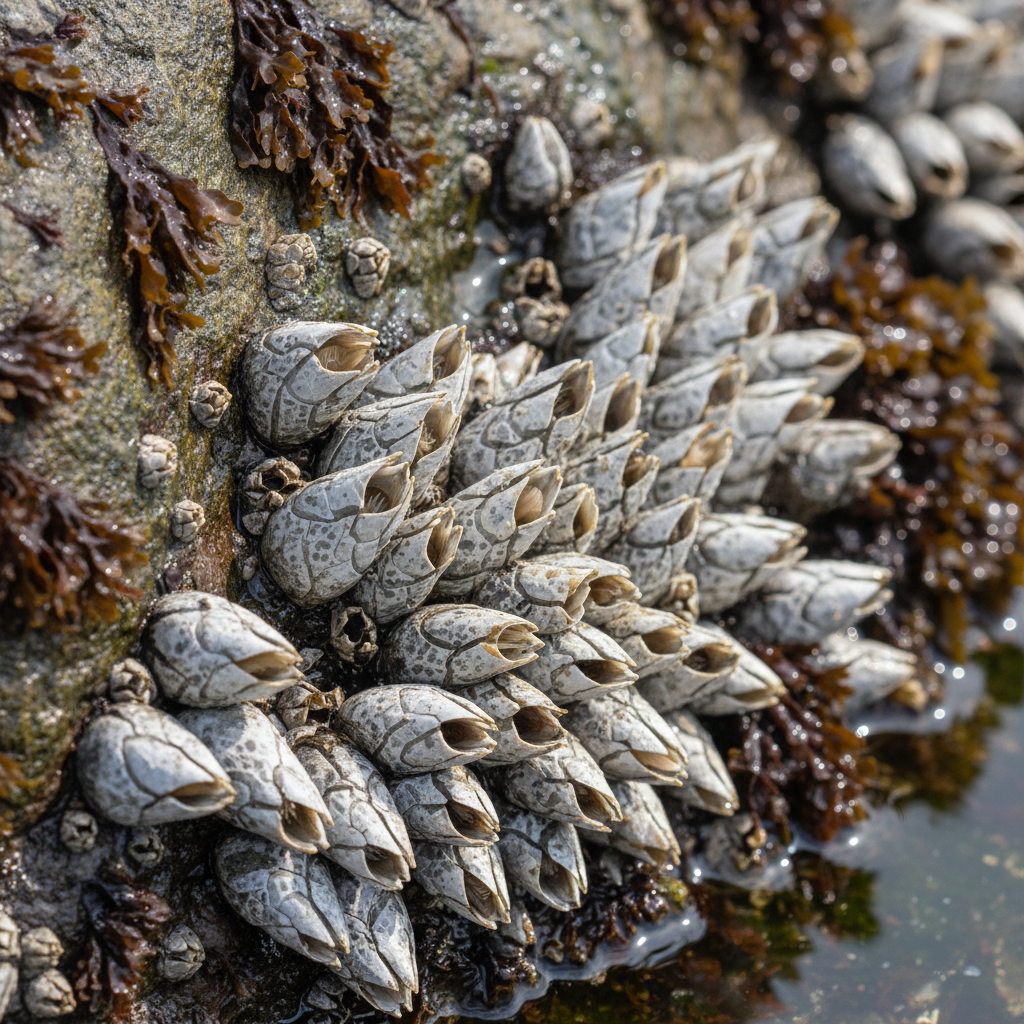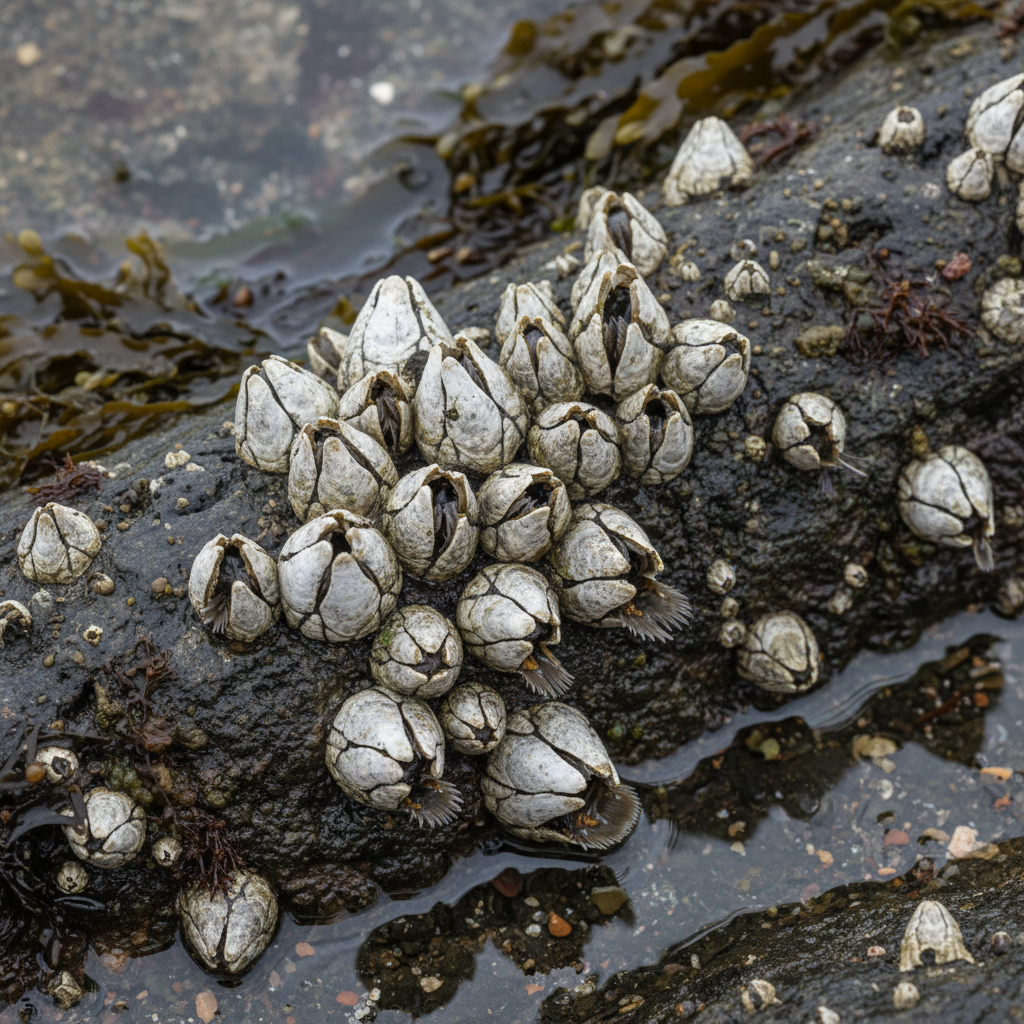Balanus: Morphology, Classification, Habitat, and Ecological Role of the Acorn Barnacle
Balanus is a genus of acorn barnacles belonging to the family Balanidae. These sessile crustaceans are abundant in marine intertidal and subtidal zones worldwide and are well-known for their hard, conical shells that form dense clusters on rocks, piers, ship hulls, and living marine animals. This species are a dominant component of rocky shore communities and play a critical role in biofouling. Their evolutionary success and adaptations for survival in challenging, high-energy coastal environments have made them a focus for ecological and biological studies.
Classification of Balanus
| Taxonomic Rank | Name | Characteristics |
|---|---|---|
| Kingdom | Animalia | Multicellular eukaryotic organisms |
| Phylum | Arthropoda | Segmented invertebrates with jointed limbs |
| Subphylum | Crustacea | Crustaceans with chitinous exoskeleton |
| Class | Thecostraca | Crustaceans with bivalved carapace or shells |
| Subclass | Cirripedia | Barnacles with feathery cirri for filter feeding |
| Order | Balanomorpha | Sessile barnacles with calcareous shells |
| Family | Balanidae | Acorn barnacles with conical, multi-plated shells |
| Genus | Balanus | Typical acorn barnacles with calcified wall and base |

Habit and Habitat
This species inhabit hard substrates in marine environments, particularly intertidal and shallow subtidal zones. They attach themselves permanently to rocks, pebbles, shells, pier pilings, ship hulls, and even marine animals using cement glands. Their shell structure and tightly closing opercular plates protect them from desiccation during low tide and predation during submersion. Balanus is a suspension feeder, extending branch-like cirri to filter plankton and organic particles from the water when submerged.
Geographical Distribution
The genus has a cosmopolitan distribution, from the Arctic to the tropics and from shallow intertidal areas down to about 150 meters. Species such as Balanus balanus occur throughout the North Atlantic, Arctic, North Pacific, and European seas, thriving in cold-water environments but also present in temperate and subtropical regions. B. glandula is a prominent species along the Pacific coasts of North America.

General Characteristics
- Commonly called as Rock barnacle or Acorn barnacle.
- Stalk is absent to the shell covering the animal is directly attached to the substratum or rocks.
- Head is short and broad. Mantle surrounding the body is covered by six calcareous plates, consisting of unpaired carina, rostrum and 2 pairs of carino-lateral plates.
- Edges of the plates overlap and fit together forming cylinder. Outer surface of each plate shows 3 divisions, a central portion and two wings.
- Opening of the shell is provided with a movable fourfold lid or operculum, composed of 2 scuta and 2 terga.
- In water the barnacle protrudes through the opening six pairs delicate, curled, fringed and jointed thoracic legs to collect food.
- Life cycle includes nauplius larva.
- Shell: Steeply conical, hard, white to greyish-brown, comprised of six primary wall plates.
- Size: Ranges from 0.5 to 5 cm in diameter, commonly 1.5 cm.
- Operculum: Pair of plates (tergum and scutum) that close over the top opening.
- Base: Solid calcareous base that cements the animal to the substrate.
- Cirri: Feathery appendages that protrude for filter feeding when submerged.
- Color: Generally white, grey, or pale brown; sometimes tinged with pink or purple.
Special Features
- Sessile Lifestyle: Permanently fixed to a substrate by proteinaceous cement glands in the antennae.
- Protective Plates: Thick shell provides defense against mechanical stress, desiccation, and predation.
- Feeding Mechanism: Cirri rhythmically extend and retract to capture planktonic food from the water.
- Crowding Adaptation: Adjusts shell shape in crowded conditions to maximize available space.
- Broad Tolerance: Withstands a range of salinity, temperature, and wave exposure; highly resilient.
- Larval Dispersal: Produces planktonic larvae (nauplius and cyprid stages) that enable wide distribution.

Identification
Balanus identification is based on—
- Shell shape, size, and number of wall plates.
- Prominence and arrangement of longitudinal ridges.
- Structure and articulation of the opercular plates.
- Color and texture of the shell.
- Geographic and substrate preference.
Life Cycle and Reproduction
They are hermaphroditic and reproduces by cross-fertilization. Fertilized eggs are brooded inside the mantle cavity until they hatch into free-swimming nauplius larvae. The nauplii develop through several stages before transforming into a non-feeding cyprid, which seeks a suitable substrate to settle and metamorphose into the adult barnacle. Growth is rapid in favorable conditions, and mature individuals can live several years.
Ecological Role and Importance
- Biofouling: Significant contributors to marine fouling communities on ships and artificial structures.
- Habitat Formation: Provide microhabitats for smaller invertebrates on rocky shores.
- Food Web: Serve as prey for starfish, snails, fish, and some birds.
- Indicator Species: Reflect environmental change, especially pollution and water quality.
- Competition: Compete intensely with other sessile organisms for space and resources.
References
- https://en.wikipedia.org/wiki/Balanus
- https://en.wikipedia.org/wiki/Balanus_balanus
- http://www.marinespecies.org/aphia.php?p=taxdetails&id=106213
- https://animaldiversity.org/accounts/Balanus/classification/
- http://www.marinespecies.org/aphia.php?p=taxdetails&id=106122
- https://www.marlin.ac.uk/species/detail/2222
- https://www.inaturalist.org/taxa/507992-Balanus-balanus
- https://racerocks.ca/balanus-glandula-common-acorn-barnacle-the-race-rocks-taxonomy/
- https://www.sciencedirect.com/topics/agricultural-and-biological-sciences/balanus
- https://www.sdnhm.org/oceanoasis/fieldguide/balanus.html
